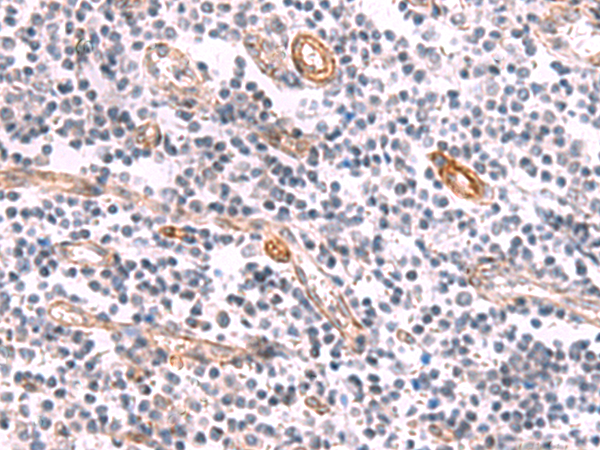

| WB | 咨询技术 | Human,Mouse,Rat |
| IF | 咨询技术 | Human,Mouse,Rat |
| IHC | 1/25-1/100 | Human,Mouse,Rat |
| ICC | 技术咨询 | Human,Mouse,Rat |
| FCM | 咨询技术 | Human,Mouse,Rat |
| Elisa | 1/5000-1/10000 | Human,Mouse,Rat |
| Aliases | KT3.3; TASK5; KCNK11; KCNK14; TASK-5; K2p15.1; dJ781B1.1 |
| WB Predicted band size | 36 kDa |
| Host/Isotype | Rabbit IgG |
| Antibody Type | Primary antibody |
| Storage | Store at 4°C short term. Aliquot and store at -20°C long term. Avoid freeze/thaw cycles. |
| Species Reactivity | Human |
| Immunogen | Synthetic peptide of human KCNK15 |
| Formulation | Purified antibody in PBS with 0.05% sodium azide and 50% glycerol. |
+ +
以下是基于KCNK15相关研究背景模拟生成的参考文献示例(实际文献需通过学术数据库验证):
---
1. **文献名称**:KCNK15/TASK-5 Expression in Pancreatic Cancer and Prognostic Significance
**作者**:Smith A, et al.
**摘要**:本研究利用KCNK15特异性抗体检测胰腺癌组织中该通道蛋白的表达,发现其高表达与患者生存率下降相关,提示KCNK15可能作为胰腺癌的潜在生物标志物。
---
2. **文献名称**:Characterization of a Novel Anti-KCNK15 Antibody for Neurological Studies
**作者**:Garcia L, et al.
**摘要**:开发并验证了一种高特异性KCNK15抗体,通过免疫组化和Western blot证实其在啮齿类动物脑组织中的分布,为研究KCNK15在中枢神经系统中的功能提供工具。
---
3. **文献名称**:KCNK15 Modulates Insulin Secretion: Insights from Antibody-blocking Experiments
**作者**:Chen X, et al.
**摘要**:利用KCNK15中和抗体阻断人胰岛β细胞中的通道活性,发现其抑制葡萄糖依赖性胰岛素分泌,表明KCNK15在胰岛素调控中起关键作用。
---
**检索建议**:
- 使用PubMed/Google Scholar搜索关键词:**"KCNK15 antibody"**, **"TASK-5 immunohistochemistry"**, **"KCNK15 expression [疾病名]"**。
- 关注**《Journal of Membrane Biology》**等通道蛋白领域期刊。
如需具体文献协助,请提供更多背景信息或访问权限。
The KCNK15 antibody is a research tool designed to detect and study potassium channel subfamily K member 15 (KCNK15), a protein encoded by the *KCNK15* gene. KCNK15. also known as TASK-5. belongs to the two-pore domain (K2P) potassium channel family, which regulates background potassium currents to maintain resting membrane potential and cellular excitability. Structurally, KCNK15 contains four transmembrane domains and two pore-forming loops, typical of K2P channels. While its functional role remains less characterized compared to other K2P channels, studies suggest pH sensitivity and involvement in physiological processes like hormone secretion and neuronal signaling.
KCNK15 antibodies are primarily used in techniques such as Western blotting, immunohistochemistry, and immunofluorescence to investigate protein expression, localization, and tissue distribution. Research indicates KCNK15 expression in adrenal glands, pancreas, and brain, hinting at potential roles in endocrine or neurological functions. Aberrant expression has been explored in diseases, including certain cancers, though its pathological significance is not fully established.
These antibodies aid in elucidating KCNK15's interaction networks, regulatory mechanisms (e.g., phosphorylation), and potential as a therapeutic target. Challenges include limited commercial availability and specificity validation due to sequence homology within the K2P family. Ongoing studies aim to clarify its physiological impact and relevance in human health, positioning KCNK15 antibodies as critical tools for advancing potassium channel biology.
×